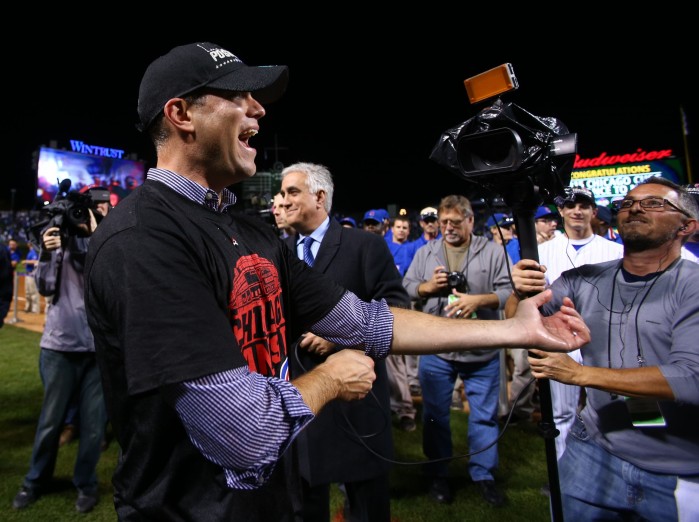If there’s one thing that makes me crazy, it’s the ‘Keep Calm and Carry On’ fad. It’s been waning in popularity for a while now, so I suppose that I should be finding new things to annoy me now. But so it goes. You can picture an old fellow in a rocking chair wearing a baseball cap yelling “get off my lawn” if you’re a more visual person.
There’s really a bunch of things that define me as a person and disliking clichés is a pretty major one. I guess that’s kind of a sad way to self-identify, but I also suppose I’m a fairly basic person. I grind my teeth if I read “patience is a virtue” or “good things come to those who wait” to help express much larger or complex ideas. Just don’t do it.
To do this, though, is to miss the more important role of a cliché. They are meant to make lessons more relatable. These are lessons you already believe to be true, being expressed in ways that you haven’t yet explored. The Brewers then, in an idiom, do lend themselves well to a sort of Keep Calm and Carry On comparison.
For those who don’t know, the Keep Calm and Carry On posters originated in 1939 as a way to subdue worry of invasion in mainland Britain during World War II. It was rarely used back then and its rise to prominence now — especially considering that context — is kind of weird. It’s the kind of cultural appropriation Western nations always employ, I suppose, but it became more strange when companies began tweaking the saying to fit their business needs.
Regardless, if I could sneak into David Stearns’ office to impart some wisdom via both poster and cliché form, I would probably pick Keep Calm and Carry On. Maybe. I mean, I wouldn’t love doing that, but if it had to be a poster with a some sort of cliché on it, then I think such a poster would be more helpful than “good fences make good neighbors” or any other alternative. I also think that’s a lesson that we should all follow to some degree. Patience can be a broad concern, and often gets misinterpreted as sloth. However, Stearns continues to make moves, so there’s no real current concern of idling.
J.P. Breen wrote an important article to discuss what methods Stearns will have to employ moving forward after the Jason Rogers trade. In it, Breen admitted following in the footsteps of the Houston Astros or Chicago Cubs, while important, can’t be Stearns’ main method. It will take some outside-of-the-box thinking for the small market Brewers to become competitive in the NL Central.
While this is definitely true, I want to highlight the one thing the Cubs and Astros did particularly well: They both waited until they actually were competitive before “going for it.” And, by going for it, I mean spending significant money on free agents, and spending high-end prospects on trades.
That’s an extremely impressive brand of patience. In my opinion, the Cubs are the true model while the Astros only serve as an additional anecdote. In retrospect, Theo Epstein probably had to make some really hard decisions last offseason. Kris ‘The Chosen One’ Bryant was definitely going to get called up at one point during the 2015 season. The temptation to push hard for the postseason last offseason must have been there for the Cubs’ front office. Despite the Cubs also signing Jon Lester, both Epstein and Jeff Luhnow spent that off-season addressing the last piece of a rebuild: the bullpen.
After his team seemed to arrive one-year ahead of schedule, Luhnow and the Astros’ front office did make some nice additions at the trade deadline for Scott Kazmir, Mike Fiers, and Carlos Gomez. While some may argue that they didn’t pay exorbitant fees to acquire that talent, it was a nice way to show the hungry Astros fanbase that they are serious about contention. It resulted in a postseason berth, after all. That’s a success in its own right.
Now that the current offseason is upon us, it’s clear that the Cubs and Astros are in a different mode, preparing to dominate Major League Baseball as best they can. Now that the Cubs are clearly contenders, they opened up their wallet to acquire Jason Heyward and traded Starlin Castro — and are probably poised to do more. The Astros dished out a massive package of prospects to get Ken Giles and should still be active in free agency. This type of “spend once you’ve already shown success” rebuilds not only seem more successful, but are also more sustainable. The Toronto Blue Jays, who have tried to rebuild on the fly while staying one of the most mediocre teams in the MLB, are in a very small window of contention for instance. Both the Cubs and Astros could conceivably go on pennant streaks, and that can be seen in the types of controllable talent they acquired.
So, while Breen is absolutely right in his assessment — that Stearns will have to find a new way to compete; find “the next market inefficiency, if you will” — that’s a very inside baseball approach. We perhaps won’t know the method ever, and we won’t know if it worked until it’s over. In the meantime, there are things we can see, diagnose, and assess as they happen. Patience is my most-earnest concern. As Breen points out again, with all the acquisitions of Rookie-ball or High-A prospects, it appears as though patience will definitely be part of the Brewers playbook under Stearns.
